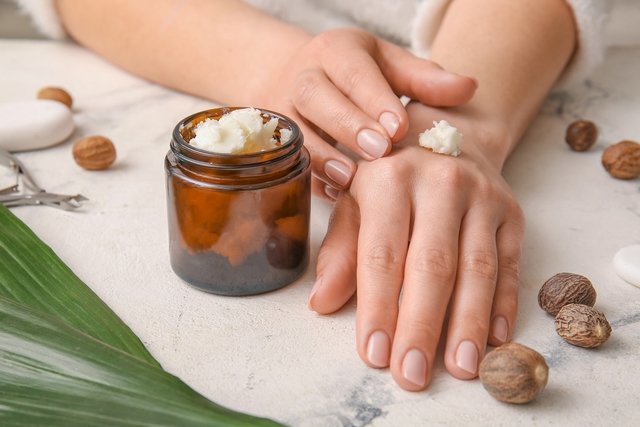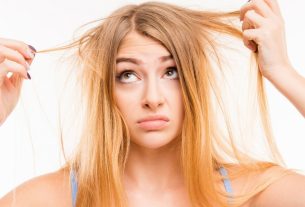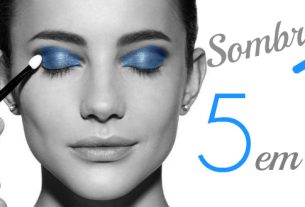Shea butter offers many benefits for the health of the skin, as it helps keep it hydrated, promotes rejuvenation and healing. These properties are due to the fact that shea butter is rich in fatty acids, such as stearic, oleic, palmitic, linoleic and arachidonic acids.
Shea butter is a solid fat obtained by pressing the seeds of the shea tree, known as Vitellaria paradoxa or V. nilotica.
This butter can be purchased at cosmetic stores or pharmacies. In addition, shea butter is also used as an ingredient in the production of moisturizers, lip balms, shampoos and conditioners, for example. Furthermore, this butter can also be used for culinary purposes.

What is it for and benefits
The main benefits and indications of shea butter are:
1. Moisturize your skin
Shea butter is easily absorbed by the skin and has good water retention properties, which helps keep the skin hydrated. This is due to its active compounds, which include fatty acids, sterols, vitamin A, vitamin E and vitamin F.
Shea butter is an excellent option for moisturizing hands and feet, preventing skin peeling after tanning, preventing the formation of stretch marks and improving rough, cracked skin or relieving conditions such as eczema, dermatitis or psoriasis, for example.
2. Prevent premature aging
Due to its bioactive compounds, shea butter prevents premature aging, stimulating cell regeneration and slowing the aging process.
Furthermore, shea butter also protects the skin against UV rays, preventing photoaging and stimulating the production of collagen, a protein responsible for giving firmness and elasticity to the skin.
3. Take care of your hair health
Shea butter takes care of hair health, acting as an emollient, moisturizer and protector against free radicals present in the air and water, because it is rich in vitamin A, vitamin E and fatty acids.
Furthermore, when shea butter is applied to the hair, it also forms a protective barrier against heat, salt and chlorine, present in environments such as swimming pools or beaches. This butter also helps to replenish the loss of moisture in the hair, caused by frequent use of dryers, straighteners and chemical treatments.
Therefore, shea butter is widely used as the main ingredient in various shampoos, conditioners and hydrating masks to treat curly, frizzy, colored, dry or damaged hair.
4. Repair chapped lips
Shea butter helps keep lip skin hydrated and promotes healing and regeneration. Therefore, this butter works as an excellent balm to prevent and repair chapped lips that can appear in cold or hot weather.
5. Promote healing
The fatty acids and sterols present in shea butter, as well as its high vitamin A content, promote skin healing and help reduce inflammation.
Therefore, shea butter can be used to help treat rashes, athlete’s foot and burns, and reduce inflammation caused by insect bites, for example.
6. Reduce skin inflammation
Shea butter contains amarine, a bioactive compound that helps reduce skin inflammation and can therefore be used topically to reduce skin swelling in cases of dermatitis, eczema and psoriasis, for example.
7. Protect your skin from the sun
Triterpenes, organic compounds present in shea butter, contribute to protecting the skin against the sun’s ultraviolet rays, as they act as a sunscreen, absorbing or reflecting part of the UV rays.
These properties of shea butter reduce the risk of sunburn and skin cancer caused by exposure to sunlight.
8. Help reduce arthritis pain
Some studies done on animals (1), indicate that using shea butter can help reduce pain associated with arthritis. This is possible due to its triterpene content, which has anti-inflammatory and antioxidant properties. However, more scientific studies are needed to prove this benefit.
Properties of shea butter
Shea butter has antioxidant, anti-inflammatory, emollient, moisturizing, healing and protective properties. These properties are due to the bioactive compounds that shea butter has, which include fatty acids, sterols, triglycerides, vitamin A, vitamin E and vitamin F.
How to use shea butter
Shea butter can be used pure on the skin, hair and lips, as follows:
1. Volcanoes
Place a little pure, unrefined shea butter in the palm of your hand and apply directly to the skin, using circular movements to facilitate absorption.
This butter can also be mixed into a body moisturizer. To do this, simply melt the pure shea butter in a water bath and add it to the moisturizer or body cream, stirring until it mixes well.
2. In the hair
You can apply pure, unrefined shea butter directly to your hair. On straight, oily or fine hair, it is recommended to apply shea butter only to the ends. For frizzy, curly or dry hair, you can apply this butter from root to tip.
After washing your hair, remove excess water with a towel and apply shea butter to your hair, massaging well. Leave to act for 30 minutes and then rinse with plenty of water. You can also use a small amount of shea butter as a leave-in styling cream.
Shea butter can also be mixed into hair masks and conditioners. To do this, melt the butter in a bain-marie and add it to the cream, mixing well.
3. On the lips
Shea butter can be applied, with your fingertips, directly to the lips, to improve hydration, combat dryness and cracking.
Read too: What to do to treat chapped and dry lips
Possible side effects
No side effects have yet been found associated with using shea butter on the skin. As it contains few proteins, which significantly reduces the risk of causing allergies. Therefore, its use is considered safe for any skin type.
However, in cases of redness, itching or inflammation of the skin, you should stop using shea butter and see a dermatologist for evaluation.

Sign up for our newsletter and stay up to date with exclusive news
that can transform your routine!
Warning: Undefined array key "title" in /home/storelat/public_html/wp-content/plugins/link-whisper-premium/templates/frontend/related-posts.php on line 12
Warning: Undefined array key "title_tag" in /home/storelat/public_html/wp-content/plugins/link-whisper-premium/templates/frontend/related-posts.php on line 13



